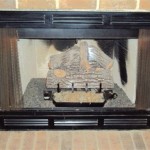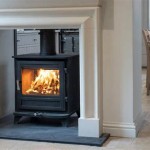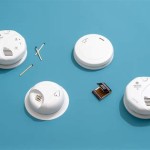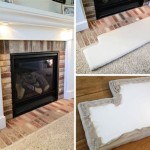How to Paint a Fireplace Mantel: A Comprehensive Guide
A fireplace mantel serves as a focal point in many living spaces, drawing attention and contributing significantly to a room's overall aesthetic. Over time, however, a mantel's finish can become worn, dated, or simply no longer align with evolving design preferences. Painting a fireplace mantel offers an effective and relatively inexpensive method of revitalizing this key architectural feature. This guide provides a detailed, step-by-step process for achieving a professional-looking painted finish on a fireplace mantel, covering preparation, painting, and finishing techniques.
Key Point 1: Preparation is Paramount
The success of any paint project hinges on thorough preparation. This stage encompasses careful cleaning, surface repair, and proper priming, all of which contribute to optimal paint adhesion and a durable, aesthetically pleasing result. Neglecting preparation can lead to paint failure, resulting in peeling, cracking, or an uneven finish.
Initial Assessment and Cleaning: Begin by assessing the current condition of the mantel. Note any existing damage, such as cracks, chips, or loose paint. Thoroughly clean the mantel using a mild detergent and water solution. Remove any dust, dirt, grease, or soot buildup, as these contaminants can interfere with paint adhesion. Rinse the mantel with clean water and allow it to dry completely. For heavily soiled mantels, a degreaser may be necessary.
Removal of Existing Finish: Depending on the existing finish and the desired aesthetic, it may be necessary to remove the existing paint or stain. If the existing finish is peeling or cracking, removal is essential. Several methods can be employed, including sanding, chemical stripping, and heat guns. Sanding is a common method for removing paint, but it can be time-consuming and generate dust. Chemical strippers can effectively remove multiple layers of paint, but require careful handling and proper ventilation. Heat guns soften the paint, allowing for easier scraping, but also pose a fire hazard if not used cautiously. Select the method that best suits the specific circumstances and ensure adequate safety precautions are taken, including wearing appropriate protective gear such as gloves, eye protection, and a respirator.
Repairing Damage: After removing the existing finish, address any damage to the mantel's surface. Fill cracks, chips, and holes with wood filler, applying it in thin layers and allowing it to dry completely between applications. Once the filler is dry, sand it smooth to blend seamlessly with the surrounding wood. For larger imperfections, multiple applications of filler and sanding may be required. Pay close attention to detail during this stage, as imperfections will be more noticeable once the mantel is painted.
Sanding for Smoothness: Sanding is crucial for creating a smooth, even surface that will accept paint uniformly. Use progressively finer grits of sandpaper, starting with a coarser grit (e.g., 120-grit) to remove any remaining imperfections and then moving to a finer grit (e.g., 220-grit) to smooth the surface. Sand in the direction of the wood grain to avoid creating scratches. After sanding, thoroughly remove all dust with a tack cloth or a vacuum cleaner with a brush attachment. Dust particles can interfere with paint adhesion and create a textured finish.
Priming for Adhesion and Coverage: Applying a primer is an essential step in painting a fireplace mantel. Primer serves several important functions: it seals the wood surface, creating a uniform base for the paint; it improves paint adhesion, preventing peeling and cracking; and it blocks stains from bleeding through the topcoat. Choose a primer that is appropriate for the type of paint being used and the type of wood the mantel is made of. For example, an oil-based primer is often recommended for blocking tannins in wood like cedar or redwood. Apply the primer in thin, even coats, following the manufacturer's instructions. Allow the primer to dry completely before proceeding to the next step. Lightly sand the primed surface with fine-grit sandpaper to remove any imperfections and create a smooth surface for the paint.
Key Point 2: Selecting the Right Paint and Applying It Correctly
Choosing the right paint is critical for achieving the desired look and durability. The type of paint, its sheen, and the application technique all contribute to the final outcome. Incorrect paint selection or application can result in a finish that is prone to chipping, fading, or an uneven appearance.
Choosing the Right Paint Type: The two primary types of paint used for fireplace mantels are latex (water-based) and oil-based paints. Latex paints are generally preferred for their ease of use, low odor, and quick drying time. They are also more environmentally friendly and easier to clean up. Oil-based paints offer excellent durability and a hard, glossy finish, but they have a strong odor, require longer drying times, and are more difficult to clean up. Consider the mantel’s location, use, and existing paint if known. Alkyd paints offer a closer performance to oil-based with easier cleanup. Select a paint that is specifically formulated for interior use and is compatible with the primer used.
Selecting the Appropriate Sheen: The sheen of the paint refers to its level of glossiness. Matte finishes have the least sheen and are good at hiding imperfections, but they are not as durable or easy to clean as higher-sheen paints. Satin finishes offer a good balance between durability and appearance, providing a subtle sheen that is easy to clean. Semi-gloss and gloss finishes are the most durable and easiest to clean, but they also highlight imperfections. For a fireplace mantel, a satin or semi-gloss finish is often recommended, as it provides a durable and attractive finish that is easy to maintain. Consider the overall style of the room and the desired aesthetic when selecting the paint sheen.
Proper Application Techniques: Apply the paint in thin, even coats using a high-quality brush, roller, or sprayer. Brushing is the most common method for painting fireplace mantels, as it allows for precise application and control. Use a brush with synthetic bristles for latex paints and a brush with natural bristles for oil-based paints. Apply the paint in the direction of the wood grain, using long, smooth strokes. Avoid applying too much paint at once, as this can lead to drips and runs. Rolling can be used for larger, flat surfaces, but it may not be suitable for intricate details or moldings. Spraying provides the most uniform finish, but it requires specialized equipment and careful masking to protect surrounding surfaces. Regardless of the application method, apply multiple thin coats of paint, allowing each coat to dry completely before applying the next. This will result in a more durable and aesthetically pleasing finish.
Sanding Between Coats: Lightly sanding between coats of paint helps to create a smooth, even surface and improves paint adhesion. Use fine-grit sandpaper (e.g., 320-grit) to lightly sand the painted surface after each coat has dried. This will remove any imperfections, such as dust particles or brush strokes. Be careful not to sand through the paint to the primer or bare wood. After sanding, thoroughly remove all dust with a tack cloth or a vacuum cleaner with a brush attachment.
Proper Drying Time: Allow each coat of paint to dry completely before applying the next coat. The drying time will vary depending on the type of paint, the humidity, and the temperature. Consult the paint manufacturer's instructions for recommended drying times. Avoid rushing the drying process, as this can lead to a soft, tacky finish that is prone to damage. Ensure adequate ventilation in the room to promote drying.
Key Point 3: Finishing Touches and Maintenance
Once the paint has dried completely, several finishing touches can enhance the mantel's appearance and protect the painted surface. Regular maintenance will help to keep the mantel looking its best for years to come. Neglecting finishing touches or maintenance can diminish the overall effect of the paint job and shorten the lifespan of the finish.
Applying a Protective Topcoat (Optional): Applying a clear topcoat can provide additional protection to the painted mantel, especially in high-traffic areas. A topcoat can also enhance the sheen of the paint or provide a matte finish if desired. Choose a topcoat that is compatible with the type of paint used and apply it in thin, even coats, following the manufacturer's instructions. Allow the topcoat to dry completely before placing any items on the mantel.
Caulking Gaps and Cracks: Inspect the mantel for any gaps or cracks between the mantel and the wall or surrounding surfaces. These gaps can allow moisture to penetrate and damage the wood. Fill any gaps or cracks with paintable caulk, applying it smoothly and evenly. Allow the caulk to dry completely before painting over it with a matching paint color.
Hardware Replacement: If the mantel has any hardware, such as brackets or decorative elements, consider replacing it with new hardware that complements the painted finish. Clean the existing hardware thoroughly or replace it with pieces that enhance the overall aesthetic. Consider the style and finish of the hardware when selecting replacements.
Regular Cleaning and Maintenance: To keep the painted fireplace mantel looking its best, clean it regularly with a soft cloth and a mild detergent solution. Avoid using abrasive cleaners or harsh chemicals, as these can damage the paint finish. Dust the mantel regularly to prevent dust buildup. Touch up any scratches or chips with a small amount of paint as needed. Avoid placing heavy or sharp objects on the mantel that could scratch or damage the paint.
Addressing High-Heat Considerations: While the mantel itself is not typically directly exposed to high heat, proximity to the fireplace opening can still cause issues. Ensure that the paint selected is suitable for the potential temperature range near the fireplace. Some paints are specifically formulated to withstand higher temperatures, and these may be a better choice, particularly for mantels that are closer to the firebox. Monitor the paint for any signs of blistering or discoloration, and take corrective action if necessary. The use of a heat shield can provide added protection.

Mantel Makeover With Paint

How To Paint Your Mantel And Get Clean Lines Postcards From The Ridge

Diy Fireplace Makeover Part Two Kilz Priming And Painting Remodelaholic

Diy Fireplace Makeover Part Two Kilz Priming And Painting Remodelaholic

My Fireplace Mantel Reveal A Makeover With Paint Setting For Four Interiors

Tiny Bits Of Happiness

Painted Fireplace Mantels Add Zz

The Fireplace Paint Color Is Beamin Moore Midnight Oil Art Patagonian Winter Print From Minted Home Painted Mantels Grey

Painted Fireplace Mantels Add Zz

My Fireplace Mantel Reveal A Makeover With Paint Setting For Four Interiors
Related Posts








